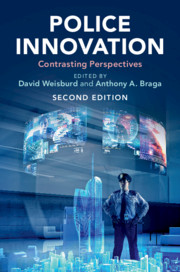Book contents
- Police Innovation
- Police Innovation
- Copyright page
- Contents
- Figures
- Tables
- Notes on Contributors
- Introduction
- Part I Community Policing
- Part II Procedural Justice Policing
- Part III Broken Windows Policing
- Part IV Problem–Oriented Policing
- Part V Pulling Levers (Focused Deterrence) Policing
- Part VI Third–Party Policing
- Part VII Hot Spots Policing
- Part VIII Predictive Policing
- Part IX CompStat
- Part X Evidence-Based/ Risk-Focused Policing
- Part XI Technology Policing
- 21 Advocate
- 22 Critic
- Conclusion
- Index
- References
22 - Critic
The Limits of Police Technology
from Part XI - Technology Policing
Published online by Cambridge University Press: 09 August 2019
- Police Innovation
- Police Innovation
- Copyright page
- Contents
- Figures
- Tables
- Notes on Contributors
- Introduction
- Part I Community Policing
- Part II Procedural Justice Policing
- Part III Broken Windows Policing
- Part IV Problem–Oriented Policing
- Part V Pulling Levers (Focused Deterrence) Policing
- Part VI Third–Party Policing
- Part VII Hot Spots Policing
- Part VIII Predictive Policing
- Part IX CompStat
- Part X Evidence-Based/ Risk-Focused Policing
- Part XI Technology Policing
- 21 Advocate
- 22 Critic
- Conclusion
- Index
- References
Summary
Technological advancements have shaped policing in many important ways over the years. One needs only to consider that the primary police strategy for much of the twentieth century – motorized preventive patrol and rapid response to calls for service – was developed in response to the invention and use of the automobile, two-way radio communications, and computer-aided dispatch systems in policing. In recent decades, there have been many significant developments with respect to information technologies, analytic systems, video surveillance systems, license plate readers, DNA testing, body-worn cameras, and other technologies that have had far-reaching effects on police agencies. Technology acquisition and deployment decisions are high priority topics for police (e.g., Koper, Taylor & Kubu, 2009), and law enforcement agencies at all levels of governments are spending vast sums on technology in the hopes of improving agency efficiency and effectiveness.
- Type
- Chapter
- Information
- Police InnovationContrasting Perspectives, pp. 517 - 543Publisher: Cambridge University PressPrint publication year: 2019
References
- 2
- Cited by



